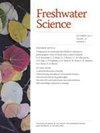The contribution of autochthonous resource to the diet of aquatic consumers is unrelated to its spatial distribution in tank bromeliads
IF 1.6
4区 环境科学与生态学
Q3 ECOLOGY
引用次数: 1
Abstract
Autochthonous biomass is heterogeneously distributed within freshwater ecosystems, shaping community structure and ecosystem functioning, yet few studies have evaluated how the spatial heterogeneity in the availability of the autochthonous resource affects its contribution to the diets of aquatic consumers. To fill this gap, we conducted a field survey to test whether the spatial heterogeneity of the autochthonous resource within freshwater ecosystems formed in tank bromeliads determines its contribution to the diet of aquatic consumers. Tank bromeliads are Neotropical plants with densely arranged leaves in a rosette shape that accumulate rainwater and terrestrial plant material, providing suitable habitat for a diversity of aquatic invertebrates. We sampled 3 regions (north, central, and south) of the bromeliad ecosystem to provide a natural gradient in the availability of the autochthonous resource (i.e., algae biomass). To trace the diets of aquatic consumers, we used stable isotope analysis of hydrogen coupled with Bayesian stable isotope mixing models. The availability of the autochthonous resource varied among the tank-bromeliad regions with light availability, but it was not related to its relative contribution to the diets of aquatic consumers. Instead, aquatic consumers from all regions showed similarly high degrees of autochthony. The capacity of aquatic consumers to move within the plant did not affect the contribution of the autochthonous resource to their diets. We reason that the contribution of the autochthonous resource to the diets of consumers is not related to its spatial distribution because aquatic consumers preferentially feed on this resource, even when its stocks are limited. In addition, water flow among tanks could provide a subsidy of the autochthonous resource from more productive to less productive regions. We conclude that spatial heterogeneity in the availability of the autochthonous resource does not limit its contribution to the diet of aquatic consumers because of active foraging on the autochthonous resource and the flux of this resource among compartments in freshwater tank-bromeliad ecosystems.本地资源对水生消费者饮食的贡献与其在箱凤梨中的空间分布无关
本地生物量在淡水生态系统中分布不均匀,形成了群落结构和生态系统功能,但很少有研究评估本地资源可用性的空间异质性如何影响其对水生消费者饮食的贡献。为了填补这一空白,我们进行了一项实地调查,以测试箱凤梨类淡水生态系统中本地资源的空间异质性是否决定了其对水生消费者饮食的贡献。水箱凤梨是一种新热带植物,叶片密集排列,呈玫瑰花结状,积累雨水和陆地植物物质,为各种水生无脊椎动物提供合适的栖息地。我们对凤梨生态系统的3个区域(北部、中部和南部)进行了采样,以提供本地资源(即藻类生物量)可用性的自然梯度。为了追踪水生消费者的饮食,我们使用了氢的稳定同位素分析和贝叶斯稳定同位素混合模型。本地资源的可利用性在具有光可利用性的槽凤梨地区各不相同,但这与其对水生消费者饮食的相对贡献无关。相反,来自所有地区的水产消费者都表现出类似的高度本地性。水生消费者在植物内活动的能力并不影响当地资源对其饮食的贡献。我们认为,本地资源对消费者饮食的贡献与其空间分布无关,因为水生消费者优先以这种资源为食,即使其库存有限。此外,水箱之间的水流可以为从生产力较高的地区到生产力较低的地区的本地资源提供补贴。我们得出的结论是,本地资源可用性的空间异质性并没有限制其对水生消费者饮食的贡献,因为对本地资源的积极觅食以及该资源在淡水槽凤梨生态系统中各隔间之间的流动。
本文章由计算机程序翻译,如有差异,请以英文原文为准。
求助全文
约1分钟内获得全文
求助全文
来源期刊

Freshwater Science
ECOLOGY-MARINE & FRESHWATER BIOLOGY
CiteScore
4.10
自引率
0.00%
发文量
49
审稿时长
6-12 weeks
期刊介绍:
Freshwater Science (FWS) publishes articles that advance understanding and environmental stewardship of all types of inland aquatic ecosystems (lakes, rivers, streams, reservoirs, subterranean, and estuaries) and ecosystems at the interface between aquatic and terrestrial habitats (wetlands, riparian areas, and floodplains). The journal regularly features papers on a wide range of topics, including physical, chemical, and biological properties of lentic and lotic habitats; ecosystem processes; structure and dynamics of populations, communities, and ecosystems; ecology, systematics, and genetics of freshwater organisms, from bacteria to vertebrates; linkages between freshwater and other ecosystems and between freshwater ecology and other aquatic sciences; bioassessment, conservation, and restoration; environmental management; and new or novel methods for basic or applied research.
 求助内容:
求助内容: 应助结果提醒方式:
应助结果提醒方式:


